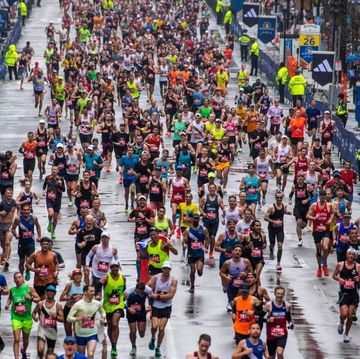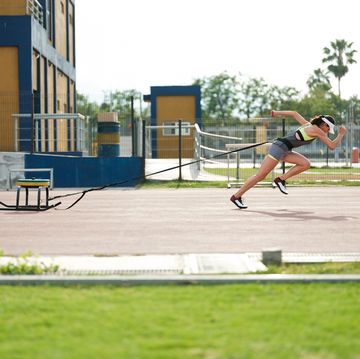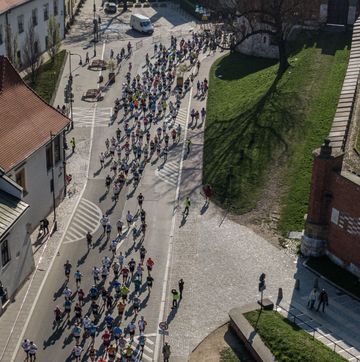If you want to improve your racing times, it is logical that you need to increase your speed. But, what is speed? Should you train to improve your top speed (which can only be maintained for a few seconds), or to maintain a faster pace over the course of a race? There are several definitions of speed, and which type of speed you aim to improve determines the types of training that you should emphasize.
Of course, for most runners speed is a relative term. For a distance runner, any training at faster than race pace will help to improve some aspect of your speed. But, which types of speed training will make best use of your precious training time? Let’s look at a few facts and misconceptions about speed training for distance runners.
If you want to improve what a sprinter would call speed (and what I will refer to as "pure speed") then you need to do short powerful accelerations and serious weight training. Pure speed training consists of up to 10 seconds of all-out sprinting with a work to rest ratio of at least one to four. This sort of training will improve your pure speed but, if you had previously been training as a distance runner, will greatly increase your likelihood of injuring various body parts. It will also do very little to improve your racing performances at distances of 3,000 meters or longer, because pure speed is irrelevant to distance running success (which is fortunate for most of us).
A second type of "speed-work" consists of high intensity repetitions of 200 to 400 meters at 1500 meter race pace or faster. This type of training (what I will refer to as "short interval training") is important for success in races of 800 to 3,000 meters. Running intervals at this pace produces high levels of lactate, improves your ability to produce energy using the glycolytic system (what you probably think of as running anaerobically), and trains your body to buffer high levels of lactate. Unfortunately, these adaptations are not particularly relevant for longer races, in which the aerobic system predominates.
So, which types of speed training are most effective for distance runners? The two types of speed training most critical to distance running success are: VO2 max training and technique training.
VO2 max training is designed to improve your maximal aerobic capacity. Your VO2 max is determined by the maximal ability of your heart to pump oxygen-rich blood to your muscles, and of your muscles to extract and utilize that oxygen to produce energy aerobically. By improving your maximal aerobic capacity, this type of training will help to improve your sustained speed, which is most important for distance running success.
The most effective training to improve your VO2 max consists of running intervals of two to six minutes duration (typically 600 to 1600 meters) at your 3K race pace. Your recovery jogs between intervals should take about 50 to 90% of the time it takes to run each repetition. The stimulus to improve your VO2 max is provided by the amount of time that you accumulate in the optimal intensity range during a workout.
Given that over 90% of your energy in races of 5K or longer is produced aerobically (and the proportion gets higher the longer the race), it is this sustained speed that you need to improve your racing performances. Running your intervals faster than 3K race pace will reduce the stimulus to improve your VO2 max by building up high levels of lactate in your muscles and shortening the duration of your workout.
The other important type of training to improve your speed is technique training, which consists of various drills to improve your running form, and strideouts which focus on running fast yet relaxed. Drills to help improve your running technique are explained in the feature article on track training, starting on page 18 of this issue.
Strideouts consist of running short repetitions (typically 80 to 120 meters) quickly while emphasizing good running technique. These sessions teach your body to eliminate unnecessary movements and to maintain correct posture and control at fast speeds, both of which help increase your coordination and speed. Strideouts are short enough, and done with sufficient rest between, that your lactate levels remain low to moderate throughout the workout and you recover quickly.
A typical session is to warm-up for 20 to 30 minutes and then run 10 repetitions of 100 meters in which you accelerate up to full speed over the first 70 meters and "float" for the last 30 meters. It’s critical to remain relaxed during these accelerations. Avoid clenching your fists, lifting your shoulders, tightening your jaw and neck muscles, etc. Concentrate on running with good form, and focus on one aspect of good form, such as relaxed arms or complete hip extension, during each acceleration. You should be relatively well-rested when doing these sessions, so you are able to maintain excellent technique throughout the workout.
Running fast, yet relaxed is an acquired skill. Runners often do not have an accurate sense of their running style. An experienced coach or a video camera can provide valuable input for assessing how you run. Your running style will improve after a few of these sessions as running with correct technique becomes more natural.












